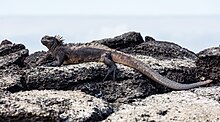Amblyrhynchus
| Marine iguana | |
|---|---|
 |
|
| Scientific classification | |
| Kingdom: | Animalia |
| Phylum: | Chordata |
| Class: | Reptilia |
| Order: | Squamata |
| Suborder: | Iguania |
| Family: | Iguanidae |
| Genus: |
Amblyrhynchus Bell, 1825 |
| Species: | A. cristatus |
| Binomial name | |
|
Amblyrhynchus cristatus Bell, 1825 |
|
| Subspecies | |
|
7–11 ssp.; see text |
|
 |
|
7–11 ssp.; see text
The marine iguana (Amblyrhynchus cristatus), also known as the Galápagos marine iguana, is a species of iguana found only on the Galápagos Islands (Ecuador) that has the ability, unique among modern lizards, to forage in the sea, making it a marine reptile. This iguana feeds almost exclusively on algae and large males dive to find this food source, while females and smaller males feed during low tide in the intertidal zone. They mainly live in colonies on rocky shores where they warm after visiting the relatively cold water or intertidal zone, but can also be seen in marshes, mangrove and beaches.
Marine iguanas vary in appearance between the different islands and several subspecies are recognized. Although relatively large numbers remain and it is locally common, this protected species is considered threatened.
Its generic name, Amblyrhynchus, is a combination of two Greek words, Ambly- from Amblus (ἀμβλυ) meaning "blunt" and rhynchus (ρυγχος) meaning "snout". Its specific name is the Latin word cristatus meaning "crested," and refers to the low crest of spines along the animal's back.
Amblyrhynchus is a monotypic genus, having only one species, Amblyrhynchus cristatus.
Researchers theorize that land iguanas (genus Conolophus) and marine iguanas evolved from a common ancestor since arriving on the islands from Central or South America, presumably by rafting. The land and marine iguanas of the Galápagos form a clade, and the nearest relative of this Galápagos clade are the Ctenosaura iguanas of Mexico and Central America. The marine iguana diverged from the land iguanas some 8–10 million years ago, which is older than any of the extant Galápagos islands. It is therefore thought that the ancestral species inhabited parts of the volcanic archipelago that are now submerged. The two species remain mutually fertile in spite of being assigned to distinct genera, and they occasionally hybridize where their ranges overlap, resulting in the so-called hybrid iguana of South Plaza Island.
...
Wikipedia

